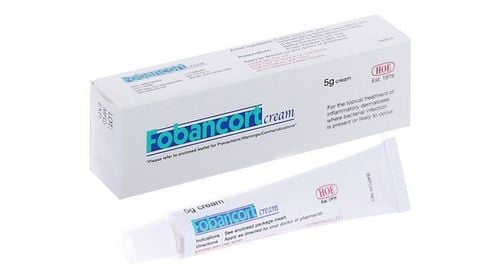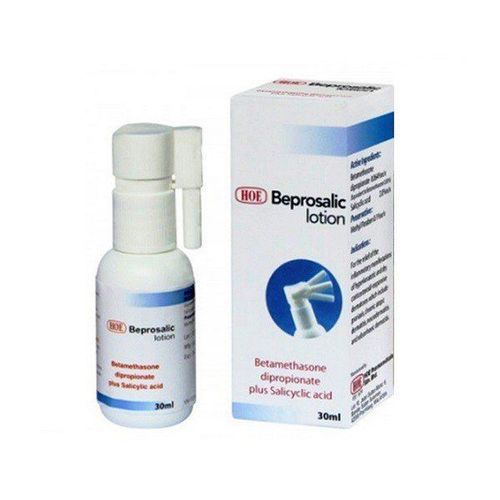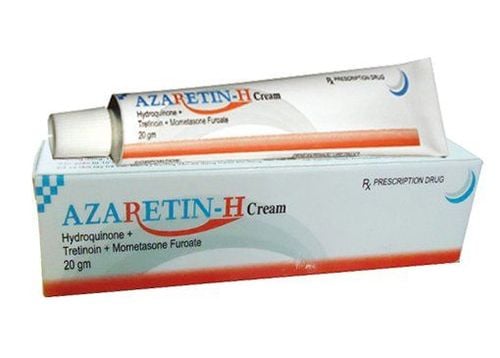This is an automatically translated article.
Hydroxychloroquine (HCQ) is known as an antimalarial drug. However, the drug is also used in the treatment of some dermatological conditions such as lupus erythematosus, slow skin porphyria, and some other conditions. The following article provides you with some information about the effects of Hydroxychloroquine in the treatment of dermatological diseases and notes when using.
1. What is Hydroxychloroquine?
Hydroxychloroquine is an antimalarial drug belonging to the 4-amino-quinoline group, which is also widely used in the treatment of systemic lupus erythematosus, rheumatoid arthritis, certain inflammatory and other sensitized conditions. sensitive to light. Hydroxychloroquine is the hydroxylated compound of chloroquine with a similar mechanism of action. However, when the same dosages of Hydroxychloroquine and Chloroquine were administered, tissue concentrations of chloroquine were 2.5 times higher than those of hydroxychloroquine. Hydroxychloroquine is preferred due to its safer properties and Hydroxychloroquine has less adverse effects on vision.The main mechanism of action of Hydroxychloroquine in the treatment of dermatological diseases, including:
Anti-inflammatory; Anti-mitotic; Immune regulation; Sunscreen; Anti-thrombotic. The anti-inflammatory effect is thought to be through multiple pathways that decrease cytokine production and include activities related to an increase in lysosome pH. This causes:
Decreased protease activity; Decreased activation of Toll-like receptors 9, 7, 8 and 3; Increased stimulation of CD8 T-cells. Hydroxychloroquine has a 2-fold effect on T cells. It inhibits CD4 T-cell stimulation, but also promotes CD8 T-cell stimulation. The synergistic effect is a beneficial immunomodulatory action that does not give rise to opportunistic infections.
The antiproliferative and immunomodulatory effects are mediated by reducing lymphocyte proliferation, interfering with natural killer cell activity, and possibly altering change the production of antibodies in the body.
The sun protection effects of Hydroxychloroquine are not completely understood. Some theories are that the accumulation of Hydroxychloroquine in the skin creates a protective barrier from the sun by absorbing certain wavelengths of light. In addition, the anti-inflammatory effect of Hydroxychloroquine reduces the inflammatory response of keratinocytes that are normally activated by sun exposure.
Antimalarials that block platelet aggregation and act as prostaglandin antagonists by inhibiting phospholipase A2. Therefore, Hydroxychloroquine can be used as a long-term therapy for patients with systemic lupus erythematosus at high risk for cardiovascular disease.
Other effects of hydroxychloroquine include:
15-20% reduction in blood cholesterol, triglyceride and LDL cholesterol levels. Lowers blood glucose by reducing insulin degradation. Antiviral properties. Prevent cancer. Increases bone mineral density in the spine and hip region.
2. Indications to use Hydroxychloroquine in dermatological treatment
Hydroxychloroquine is used as a first-line drug for the following indications in dermatology:
Lupus erythematosus of all types. Slow skin porphyria. Hydroxychloroquine is used as a second or third treatment option for the following in dermatology:
Dermatomyositis. Sarcoidosis . The board varied due to the light. Diffuse annular granuloma. Other dermatological conditions for which hydroxychloroquine may be considered, mainly those associated with photosensitivity, include:
Photopruritic papules; Chronic photodermatitis; Antiphospholipid syndrome ; Atopic dermatitis; Erythema red; Epidermolysis bullosa; Forehead fibrous hair loss; Graft-versus-host disease; Lichen planus disease caused by light; Light urticaria; Systemic scleroderma ; Urticaria; Vasculitis.
3. What are the contraindications to Hydroxychloroquine?
Contraindications to Hydroxychloroquine include:
Hypersensitivity to hydroxychloroquine or 4-aminoquinoline; Children under six years of age, due to an increased risk of overdose; Patients receiving Tamoxifen because concomitant use of Hydroxychloroquine and Tamoxifen increases the risk of retinopathy; History of retinopathy; On treatment with bone marrow suppression therapy. Some relative contraindications such as: patients with severe renal impairment (requiring dose reduction), liver failure, blood disease, G6PD enzyme deficiency, neuromuscular disease, mental illness, psoriasis.
4. Dosage of hydroxychloroquine
Hydroxychloroquine is prepared in the form of tablets with a strength of 200mg. Hydroxychloroquine should be taken with a meal or with a glass of milk to help minimize gastrointestinal side effects.
Alternating dose may be applied. For example, use Hydroxychloroquine 400mg alternating with Hydroxychloroquine 200mg daily to achieve an effective daily dose of 300mg/day. If a therapeutic response is not achieved with hydroxychloroquine alone, the addition of quinacrine may improve treatment efficacy.
Lupus erythematosus:
The usual dose is 200-400 mg daily until a therapeutic response is achieved. Although the maximum dose previously administered is usually calculated based on the patient's body weight with the recommended dose not exceeding 6.5 mg/kg/day, the current recommended dose does not exceed 5 mg/day. kg/day. However, this recommendation may need to be adjusted in obese patients because the maximum daily dose should not exceed 400 mg/day. To minimize the occurrence of retinal toxicity, the dose should be reduced as tolerated by the patient (during the winter months). Slow skin porphyria:
Use Hydroxychloroquine with a low dose, increase slowly. Recommended dose: Hydroxychloroquine 100mg twice a week for one month, then 200mg/day. Take the medicine until porphyrin blood levels are normal for at least one month. Initiation with high doses may lead to hepatotoxicity due to rapid mobilization of hepatic porphyrin stores.
5. Precautions when using Hydroxychloroquine
More frequent monitoring is needed if laboratory values are abnormal or in high-risk patients: The patient's blood count, renal function and liver function should be checked before taking Hydroxychloroquine and after that checks periodically. Pregnancy testing is performed in women of childbearing age before taking the drug and it is recommended to use contraception during treatment. All patients should be referred to an ophthalmologist before and within the first year of treatment. In the absence of additional risk factors, annual screening within 5 years should be performed. The concentration of hydroxychloroquine can be measured in the blood. This can be used to monitor patient adherence and when clinical response is inadequate. Hydroxychloroquine has a lower risk of eye, corneal, and retinal toxicity than chloroquine. Smoking can decrease the effectiveness of Hydroxychloroquine. Hydroxychloroquine has an unusually high affinity for melanin-containing cells (eg, in the skin and retina). Deposits in these cells can lead to hyperpigmentation and possibly retinal toxicity. Pregnancy: Hydroxychloroquine crosses the placenta. However, in multiple studies, use of hydroxychloroquine during pregnancy was not associated with birth defects, stillbirth, preterm birth, low birth weight, or retinopathy following maternal oral administration of hydroxychloroquine at recommended doses. Some experts now recommend that Hydroxychloroquine can be continued during pregnancy and lactation. Hydroxychloroquine is considered safer than chloroquine when it is necessary to use the drug in women planning pregnancy or breast-feeding.
6. Undesirable effects of Hydroxychloroquine
Ocular side effects:
Hydroxychloroquine may cause irreversible retinal toxicity, but Hydroxychloroquine is considered to have less retinal toxicity than chloroquine and the drug does not deposit the cornea compared with chloroquine treatment. Hydroxychloroquine's high affinity for melanin-containing cells such as those found in the retinal pigment epithelium is thought to be responsible for this side effect.
The risk of retinal toxicity depends on several factors:
Daily dose of hydroxychloroquine > 5.0 mg/kg body weight. Severe kidney failure. Concomitant use with tamoxifen. Use time > 5 years. Some studies recommend that before taking hydroxychloroquine, an eye exam should be performed in patients planning to be treated with hydroxychloroquine for a long time. Basic examination alone is not sufficient for screening and other tests are required including at least automated image field testing and spectral domain-associated optical tomography.
All patients should have a baseline eye exam within the first year of starting hydroxychloroquine if long-term use is planned. In the absence of the risk factors listed above, annual screening within 5 years is recommended for patients.
Sunglasses may be recommended to avoid further damage to the retina from sun exposure.
Patients with hydroxychloroquine retinal toxicity will not have any visual symptoms in the early stages, and only develop clinical symptoms in the late stages with severe retinal damage. Therefore, it is essential to adhere to the screening recommendations outlined above and that Hydroxychloroquine should be discontinued if definitive signs of retinopathy are observed. Retinal damage is irreversible, but usually stops progressing after hydroxychloroquine is discontinued.
Gastrointestinal side effects:
Nausea, vomiting and diarrhea are common side effects, but they are usually transient or disappear when the dose of Hydroxychloroquine is reduced. These symptoms can be relieved by taking hydroxychloroquine with food. Skin side effects:
Gray-green hyperpigmentation affects 25% of patients taking Hydroxychloroquine, especially in areas where bruising is already present. Bandages of nail pigmentation and mucosal hyperpigmentation have also been reported. Rash may occur in 10% of patients. Note that adverse skin reactions with hydroxychloroquine are reported to affect >30% of patients with dermatomyositis, whereas the risk of rash is lower in patients with lupus erythematosus. In the event of a rash, hydroxychloroquine should be discontinued and possibly restarted at a lower dose. Less common skin side effects may include:
Urticaria Lichenoid rash Alopecia areata Sensitivity to light Exfoliative dermatitis Serious adverse skin reactions Drug hypersensitivity syndrome Stevens-Johnson syndrome Toxic epidermal necrolysis Hematologic effects:
Hematologic side effects are rare. Hemolysis can be seen in patients with glucose-6-phosphate dehydrogenase (G6PD) deficiency, and hemolytic anemia and leukopenia have been reported.
7. Drug interactions
Hydroxychloroquine increases plasma concentrations of: Digoxin, Methotrexate, D-penicillamine, Ciclosporin, beta-blockers. Penicillin: Hydroxychloroquine reduces the bioavailability of penicillin when administered concomitantly. Increased concentrations of Hydroxychloroquine when co-administered with Cimetidine, Ritonavir. The basic information about Hydroxychloroquine in the above article is for reference only. Because this is a prescription drug, patients should not use it on their own, but need to contact a specialist directly to get an appropriate prescription to ensure safety for health.













